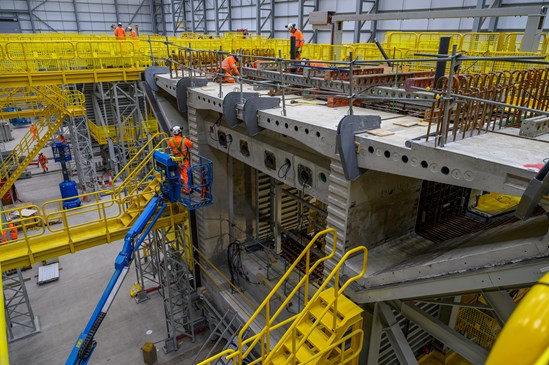Work on the UK’s longest railway bridge ramped up this week as HS2 began production of 1,000 enormous concrete segments that will form the deck of the Colne Valley Viaduct.
Stretching for 2.1 miles (3.4km) across a series of lakes and waterways just outside London, the viaduct will carry high-speed trains as part of the HS2 project, designed to improve rail links between London, Birmingham and North, boost the economy and provide a low carbon alternative to car and air travel.
The huge deck segments – which weigh up to 140 tonnes – are being made on site at a temporary factory built specifically for the project. The mammoth 100m long building, which is visible from the M25, has an internal volume of 105,000 cubic metres – making it larger than the Royal Albert Hall.
HS2 Project Client, David Emms said:
“We’re already making strong progress on the Colne Valley Viaduct – sinking the foundations, building the first piers, and now starting production at the new modular viaduct factory. Once complete, this iconic structure will carry trains at up to 200mph – improving connections across the UK, freeing up rail capacity and offering passengers low carbon travel options.
“It’s great to see how much progress has been made and I look forward to seeing work on assembling the deck structure later this year.”
Every segment will be a slightly different shape depending on where it fits into the viaduct and the modular approach was chosen to ensure quality, safety and efficiency in production and to avoid bringing them in by road.
At the peak of construction, around 12 segments – each the size of a double-decker bus - will be cast every week using a ‘match-casting’ technique. This approach - where each segment is poured against the previous one - will ensure the whole arch fits perfectly when reassembled on site.
The huge project is being led by engineers from HS2’s main works contractor Align JV – a team made up of Bouygues Travaux Publics, Sir Robert McAlpine, and VolkerFitzpatrick.
Once construction is complete, the factory and surrounding buildings will be removed and the whole area between the viaduct and the Chiltern tunnel will be transformed into an area of chalk grassland and woodland as part of HS2’s ‘green corridor’ project.
Daniel Altier, Align Project Director
“Seeing the first deck segments being cast in the factory marks a significant milestone for the project. The design of the viaduct is such that each segment will be unique, delivering a structure which I have no doubt will be one of the most striking elements of HS2 once complete.
“I would like to thank all the Align team and our supply chain partners that have enabled us to get to where we are today and in particular VSL, Danny Sullivan, Sendin and Tarmac.”
The design of the Colne Valley Viaduct was inspired by the flight of a stone skipping across the water, with a series of elegant spans, some up to 80m long, carrying the railway around 10m above the surface of the lakes, River Colne and Grand Union Canal.
Set low into the landscape, wider spans will carry the viaduct crosses the lakes, with narrower spans for the approaches. This design was chosen to enable views across the landscape, minimise the viaduct’s footprint on the lakes and help complement views across the natural surroundings.
Work has also begun on the 56 giant piers that will support the viaduct, working from north to south. Weighing in at around 370 tonnes, the first 6m tall reinforced concrete pier was cast on site by a team of engineers who used a specially-designed formwork to create the shape of the structure. This was then removed after 4 days to reveal the final product.
Each pier is designed to support the full weight of the deck above and rests on a set of concrete piles going up to 55m into the ground. This foundation work began earlier this year and will require the construction of 292 piles and 56 pile caps across the whole length of the viaduct.
Once complete, the team will then use a specialised ‘launching girder’ resting on top of the piers to lift the deck segments into position.
In another visible sign of progress on the project, the team have also completed the construction of the first two of four jetties across the lakes to get equipment into position to support the construction thereby taking construction vehicles off local roads. Where the viaduct crosses the lakes, the piles are being bored directly into the lakebed, using a cofferdam to hold back the water while the pier is constructed.

